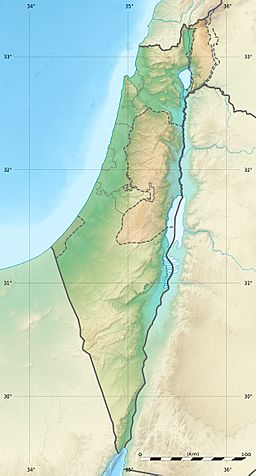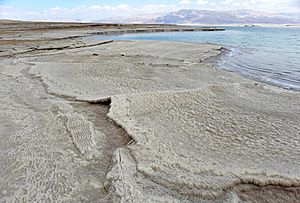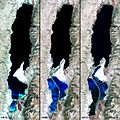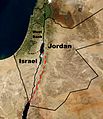Dead Sea facts for kids
Quick facts for kids Dead Sea |
|
|---|---|
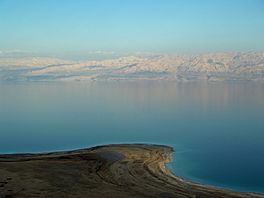
A view of the sea from the Israeli shore
|
|
| Location | Western Asia |
| Coordinates | 31°30′N 35°30′E / 31.500°N 35.500°E |
| Lake type | Endorheic Hypersaline |
| Native name | |
| Primary inflows | Jordan River |
| Primary outflows | None |
| Catchment area | 41,650 km2 (16,080 sq mi) |
| Basin countries | Israel, Jordan, and the West Bank |
| Max. length | 50 km (31 mi) (northern basin only) |
| Max. width | 15 km (9.3 mi) |
| Surface area | 605 km2 (234 sq mi) (2016) |
| Average depth | 199 m (653 ft) |
| Max. depth | 298 m (978 ft) (elevation of deepest point, 728 m BSL [below sea level], minus current surface elevation) |
| Water volume | 114 km3 (27 cu mi) |
| Shore length1 | 135 km (84 mi) |
| Surface elevation | −430.5 m (−1,412 ft) (2016) |
| 1 Shore length is not a well-defined measure. | |
The Dead Sea is a very salty lake located between the West Bank and Jordan. It is 418 metres (1,371 feet) (about 1,371 feet) below sea level. This makes it the lowest point on the surface of the Earth!
The Dead Sea is almost nine times saltier than the ocean. Because of this extreme saltiness, most living things, like fish and plants, cannot survive in it. This is why it's called the "Dead Sea." However, it's not completely dead! Some tiny living things, like certain types of bacteria, are able to live in its unique water.
Since the water is so salty, it is much denser and heavier than fresh water. This special quality allows people to float easily in the Dead Sea without any effort. Many tourists from all over the world visit just to experience floating in its waters.
Contents
Where is the Dead Sea?
The Dead Sea is a special type of lake called an endorheic lake. This means water flows into it, but no rivers flow out. It is located in the Jordan Rift Valley. This valley was formed by a huge crack in the Earth's crust called the Dead Sea Transform. This crack is where two large tectonic plates, the African Plate and the Arabian Plate, meet and slowly move past each other.
The Jordan River is the main source of water flowing into the Dead Sea. There are also small springs under and around the lake. These springs create small pools and even areas of quicksand along the edges.
The Dead Sea area gets very little rain. The northern part gets less than 100 mm (4 in) (4 inches) of rain each year, and the southern part gets even less, barely 50 mm (2 in) (2 inches). This dry climate is because of the rain shadow effect from the Judean Hills. These hills block rain clouds from reaching the Dead Sea.
On the western side of the Dead Sea, the Judean Hills are not as steep or tall as the mountains on the eastern side. Along the southwestern edge of the lake, there is a 210 m (700 ft) (689 feet) tall rock formation made of halite (rock salt) called "Mount Sodom".
How the Dead Sea Formed
Scientists have two main ideas about how the Dead Sea got so low. One idea is that it's part of a true rift zone, like an extension of the Red Sea Rift or even the larger Great Rift Valley in East Africa. Another idea is that the Dead Sea basin formed because of a "step-over" along the Dead Sea Transform fault. This movement caused the Earth's crust to stretch and sink.
About three million years ago, the area that is now the Jordan River valley and the Dead Sea was often covered by water from the Mediterranean Sea. This water formed a long, winding bay connected to the sea. The floods came and went depending on big climate changes. A very old lake, called Lake Sedom, once filled the Dead Sea Rift. It left behind thick layers of salt, which are now about 3 km (2 mi) (1.8 miles) deep.
Around two million years ago, the land between the Rift Valley and the Mediterranean Sea rose up. This meant the ocean could no longer flood the area, and the long bay became a lake.
The first prehistoric lake in this area was called "Lake Amora." It was a freshwater or brackish (slightly salty) lake. It stretched far beyond the current Dead Sea, about 80 km (50 mi) (50 miles) south and 100 km (60 mi) (62 miles) north. As the climate became drier, Lake Amora shrank and got saltier. The large, saltwater lake that came before the Dead Sea is known as "Lake Lisan."
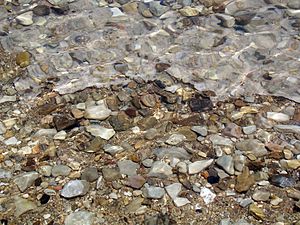
Over prehistoric times, a lot of sediment (like mud and sand) piled up on the bottom of Lake Amora. This sediment was heavier than the salt layers. It squeezed the salt layers upwards, forming what are now the Lisan Peninsula and Mount Sodom. Imagine putting a heavy stone into a bucket of mud; the mud would creep up the sides! Later, when the Dead Sea floor sank even more due to tectonic forces, these salt formations stayed as high cliffs.
From 70,000 to 12,000 years ago, the lake level was much higher than it is today, between 100 m (330 ft) (328 feet) and 250 m (820 ft) (820 feet) higher. This lake, called "Lake Lisan", changed a lot. It reached its highest level about 26,000 years ago, suggesting a very wet climate in the Near East. Around 10,000 years ago, the lake level dropped quickly, possibly even lower than it is now. Over the last few thousand years, the lake has gone up and down by about 400 m (1,300 ft) (1,312 feet). Scientists think these big changes were caused by earthquakes, not volcanoes.
Climate and Weather
The Dead Sea region enjoys sunny skies and dry air all year round. It receives less than 50 millimetres (2 in) (2 inches) of rain annually. In summer, the average temperature is between 32 and 39 °C (90 and 102 °F) (90 and 102°F). In winter, average temperatures range from 20 and 23 °C (68 and 73 °F) (68 to 73°F).
The air here also has less harmful ultraviolet radiation, especially UVB rays. Plus, the air has more oxygen because of the higher barometric pressure at this low elevation. The large body of water also helps keep temperatures mild, making winters warmer and summers cooler near the shore compared to inland areas. This is because water holds heat well. On average, there are 192 days a year when the temperature is above 30°C (86°F).
| Climate data for Dead Sea | |||||||||||||
|---|---|---|---|---|---|---|---|---|---|---|---|---|---|
| Month | Jan | Feb | Mar | Apr | May | Jun | Jul | Aug | Sep | Oct | Nov | Dec | Year |
| Record high °C (°F) | 26.4 (79.5) |
30.4 (86.7) |
33.8 (92.8) |
42.5 (108.5) |
45.0 (113.0) |
46.4 (115.5) |
47.0 (116.6) |
44.5 (112.1) |
43.6 (110.5) |
40.0 (104.0) |
35.0 (95.0) |
28.5 (83.3) |
47.0 (116.6) |
| Mean daily maximum °C (°F) | 20.5 (68.9) |
21.7 (71.1) |
24.8 (76.6) |
29.9 (85.8) |
34.1 (93.4) |
37.6 (99.7) |
39.7 (103.5) |
39.0 (102.2) |
36.5 (97.7) |
32.4 (90.3) |
26.9 (80.4) |
21.7 (71.1) |
30.4 (86.7) |
| Mean daily minimum °C (°F) | 12.7 (54.9) |
13.7 (56.7) |
16.7 (62.1) |
20.9 (69.6) |
24.7 (76.5) |
27.6 (81.7) |
29.6 (85.3) |
29.9 (85.8) |
28.3 (82.9) |
24.7 (76.5) |
19.3 (66.7) |
14.1 (57.4) |
21.9 (71.4) |
| Record low °C (°F) | 5.4 (41.7) |
6.0 (42.8) |
8.0 (46.4) |
11.5 (52.7) |
19.0 (66.2) |
23.0 (73.4) |
26.0 (78.8) |
26.8 (80.2) |
24.2 (75.6) |
17.0 (62.6) |
9.8 (49.6) |
6.0 (42.8) |
5.4 (41.7) |
| Average precipitation mm (inches) | 7.8 (0.31) |
9.0 (0.35) |
7.6 (0.30) |
4.3 (0.17) |
0.2 (0.01) |
0.0 (0.0) |
0.0 (0.0) |
0.0 (0.0) |
0.0 (0.0) |
1.2 (0.05) |
3.5 (0.14) |
8.3 (0.33) |
41.9 (1.65) |
| Average precipitation days | 3.3 | 3.5 | 2.5 | 1.3 | 0.2 | 0.0 | 0.0 | 0.0 | 0.0 | 0.4 | 1.6 | 2.8 | 15.6 |
| Average relative humidity (%) | 41 | 38 | 33 | 27 | 24 | 23 | 24 | 27 | 31 | 33 | 36 | 41 | 32 |
| Source: Israel Meteorological Service | |||||||||||||
What is the Dead Sea Made Of?
Until the winter of 1978–79, the Dead Sea had two layers of water. These layers were different in temperature, density, and saltiness. The top layer, about 35 meters (115 ft) (115 feet) deep, had salt levels between 30% and 40%. Its temperature changed from 19 °C (66 °F) (66°F) to 37 °C (99 °F) (99°F). Below this, the bottom layer had a steady temperature of 22 °C (72 °F) (72°F) and was completely full of sodium chloride (common salt). Because the bottom water was so salty, the salt would fall out of the water and settle on the sea floor.
Starting in the 1960s, less water flowed into the Dead Sea from the Jordan River. This was due to a lot of water being used for farming and less rainfall. By 1975, the top layer of water became saltier than the bottom layer. However, it stayed on top because it was warmer and therefore less dense. When the top layer cooled down and became denser than the bottom layer, the waters finally mixed in 1978–79. For the first time in hundreds of years, the lake became one mixed body of water. Since then, the layers have slowly started to form again.
The minerals in the Dead Sea are very different from those in ocean water. The exact mix of minerals changes with the season, depth, and temperature. In the early 1980s, the Dead Sea's surface water had a lot of magnesium chloride (about 50.8%), sodium chloride (common salt, about 30.4%), calcium chloride (about 14.4%), and potassium chloride (about 4.4%). In contrast, the salt in most oceans is about 97% sodium chloride. The Dead Sea has very little sulfate but the highest amount of bromide in any water on Earth.
The salt concentration of the Dead Sea is around 31.5%. This is extremely high and makes the water very dense, about 1.24 kilograms per liter. This high density is why anyone can easily float in the Dead Sea due to natural buoyancy. It's similar to the Great Salt Lake in Utah, USA.
A strange feature of the Dead Sea is that it releases asphalt. From deep cracks, the Dead Sea constantly brings up small pieces and blocks of this black, sticky substance. Ancient objects covered in asphalt, like figurines and Neolithic skulls, have been found near the Dead Sea. The Egyptians even used asphalt from this region for their mummification processes.
Health Benefits and Therapies
The Dead Sea area has become a popular place for health research and treatment. This is because of several unique features:
- The special minerals in the water.
- Very low amounts of pollen and other things that cause allergies in the air.
- Reduced harmful ultraviolet rays from the sun.
- Higher atmospheric pressure due to its very low elevation.
These features can have specific health effects. For example, people with breathing problems like cystic fibrosis may feel better due to the increased atmospheric pressure.
The climate and low elevation of the Dead Sea region make it a great place for different types of therapies:
- Climatotherapy: Using the local climate, like temperature, humidity, sunshine, and air pressure, for treatment.
- Heliotherapy: Using the sun's rays for health benefits.
- Thalassotherapy: Taking baths in the Dead Sea water for treatment.
Treating Skin Conditions
Climatotherapy at the Dead Sea is a good treatment for people with psoriasis, a skin condition. They can sunbathe for long periods because the Dead Sea's low elevation reduces many of the sun's harmful UV rays.
Helping with Sinus Problems
Studies have shown that people with rhinosinusitis (sinus problems) who used Dead Sea salt water for nasal irrigation felt much better than those who used regular saline spray.
Relieving Joint Pain
Applying Dead Sea mud packs has been suggested to temporarily ease pain for people with osteoarthritis in their knees. Researchers from the Ben-Gurion University of the Negev believe that mineral-rich mud compresses can help alongside regular medical treatments.
Animals and Plants
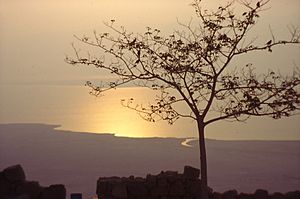
The sea is called "dead" because its very high saltiness stops large water creatures, like fish and aquatic plants, from living in it. However, tiny amounts of bacteria and small fungi can be found there.
When there are big floods, the salt content of the Dead Sea can drop from its usual 35% to 30% or even lower. After very rainy winters, the Dead Sea can temporarily come to life. In 1980, after a very wet winter, the normally dark blue Dead Sea turned red! Researchers found that the Dead Sea was full of a type of algae called Dunaliella. These algae then fed red-colored halobacteria, and their presence made the water turn red. Since 1980, the Dead Sea basin has been dry, and these algae and bacteria have not returned in large numbers.
Many animal species live in the mountains around the Dead Sea. Hikers might see camels, ibex (wild goats), hares, hyraxes, jackals, foxes, and even leopards. Hundreds of bird species also live in this area. Both Jordan and Israel have created nature reserves around the Dead Sea to protect these animals.
The area where the Jordan River flows into the Dead Sea used to be a thick jungle of papyrus and palm trees. The Jewish historian Flavius Josephus described Jericho as "the most fertile spot in Judea". In Roman and Byzantine times, plants like sugarcane, henna, and sycamore fig made the lower Jordan valley very rich. One of Jericho's most valuable products was the sap from the balsam tree, which was used to make perfume. By the 19th century, Jericho's rich plant life had mostly disappeared.
Communities and Roads
There are a few small communities near the Dead Sea. These include Ein Gedi, Neve Zohar, and Israeli settlements like Kalya, Mitzpe Shalem, and Avnat in the Megilot Regional Council. There's a nature preserve at Ein Gedi, and several Dead Sea hotels are located at Ein Bokek near Neve Zohar. Highway 90 runs along the Israeli side, stretching for 565 km (351 mi) (351 miles) from the Lebanese border in the north to the Egyptian border in the south.
On the Jordanian side, there's a small community called Potash City. Highway 65 runs north-south along the Jordanian shore.
Historical Importance
Just north of the Dead Sea is the ancient city of Jericho. Somewhere, possibly on the southeastern shore, were the cities mentioned in the Book of Genesis that were said to have been destroyed in the time of Abraham. These include Sodom and Gomorra and three other "Cities of the Plain": Admah, Zeboim, and Zoar. Zoar was saved when Abraham's nephew Lot escaped there from Sodom. Before the destruction, the Dead Sea area was a valley full of natural tar pits, known as the vale of Siddim. It is said that King David hid from Saul at nearby Ein Gedi.
In the Bible, the Dead Sea is also called the Salt Sea, the Sea of the Arabah, and the Eastern Sea. The name "Dead Sea" is a modern name and does not appear in the Bible. The Dead Sea basin is part of the Great Rift Valley, where the Jordan River system ends. Because it was so remote, the Dead Sea area was a place of escape and refuge. Greek Orthodox monks have lived in monasteries here since the Byzantine era, such as Saint George in Wadi Kelt and Mar Saba in the Judaean Desert. These are now places of pilgrimage.

Ancient Times and Discoveries
People living in caves near the Dead Sea are mentioned in the Hebrew Bible even before the Israelites arrived in Canaan, and especially during the time of King David. Different groups of Jews settled in caves overlooking the Dead Sea. The most famous are the Essenes of Qumran, who left behind a large collection of writings known as the Dead Sea Scrolls. The town of Ein Gedi was known for producing persimmon for temple fragrances and for export, using a secret recipe. The "salt of Sodom" was an important mineral for holy incense in the temple.
Aristotle wrote about the Dead Sea's amazing waters. The Nabataeans and other ancient people discovered the value of the natural asphalt that floated to the surface. They would collect it with nets. The Egyptians were regular buyers, using asphalt in their embalming process to create mummies. The Ancient Romans called the Dead Sea "Palus Asphaltites" (Asphalt Lake).
King Herod the Great built or rebuilt several strongholds and palaces on the western side of the Dead Sea. The most famous was Masada. Here, from 70–73 CE, a small group of Jewish zealots bravely resisted the powerful Roman legion. Another important site was Machaerus, where, according to Josephus, John the Baptist was imprisoned and died.
In Roman times, some Essenes settled on the western shore of the Dead Sea. Pliny the Elder described their location as "on the west side of the Dead Sea, away from the coast ... [above] the town of Engeda." This is why many believe the Essenes were the settlers at Qumran, and that the Dead Sea Scrolls found in nearby caves were their library.
Modern Discoveries
Explorers and scientists came to the area to study the minerals and the unique climate. In the late 1940s and early 1950s, hundreds of ancient religious documents were found in caves near the old settlement of Qumran. These documents, dating from 150 BCE to 70 CE, became famous as the Dead Sea Scrolls. A golf course named for Sodom and Gomorrah was even built by the British at Kalya on the northern shore.
The world's lowest road, Highway 90, runs along the Israeli and West Bank shores of the Dead Sea. It is about 393 m (1,289 ft) (1,289 feet) below sea level.
The first big hotels were built in nearby Arad. Since the 1960s, more resorts have opened at the Neve Zohar complex. On the Jordanian side, several international hotel chains have opened seaside resort hotels near the King Hussein Bin Talal Convention Center along the eastern coast.
Industry and Resources


In the early 1900s, chemists became interested in the Dead Sea because they realized it was a natural source of potash (potassium chloride) and bromine. The Palestine Potash Company was started in 1929 by Moshe Novomeysky, who worked for over ten years to get the company approved. The first factory was on the north shore at Kalya. It produced potash by letting the salty water evaporate in the sun. This company hired both Arabs and Jews and was a peaceful place during difficult times. It quickly became the largest industrial site in the Middle East. In 1934, a second factory was built on the southwest shore, near Mount Sodom. The Palestine Potash Company supplied half of Britain's potash during World War II. After the 1948 Arab–Israeli War, the company's remaining parts were taken over by the government, and Dead Sea Works Ltd. was created in 1952. This new company, owned by the state, continued to extract potash and other minerals.
From the Dead Sea's salty water, Israel produces a lot of potash, bromine, caustic soda, magnesium metal, and common salt. On the Jordanian side, Arab Potash (APC), started in 1956, produces 2.0 million tons of potash each year, along with common salt and bromine. Both companies use large salt evaporation ponds. These ponds have basically created walls across the entire southern end of the Dead Sea to produce a mineral called carnallite. This mineral is then processed to make potassium chloride. The ponds are separated by a central wall that runs along the border between Israel and Jordan. The power plant on the Israeli side helps produce magnesium metal.
Because of the Dead Sea's famous healing properties, many companies are also interested in making and selling Dead Sea salts for body and skin care products.
Images for kids
-
World's lowest (dry) point, Jordan, 1971
-
Kempinski Hotel, one of the many hotels on the Jordanian shore
-
Gully in unconsolidated Dead Sea sediments exposed by recession of water levels. It was excavated by floods from the Judean Mountains in less than a year.
See also
 In Spanish: Mar Muerto para niños
In Spanish: Mar Muerto para niños


